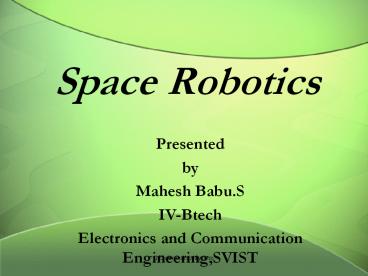Space Robotics - PowerPoint PPT Presentation
Title:
Space Robotics
Description:
Large thermal gradients -distortion . ... For them space robotics will throw open the door to explore and experience the universe. 123seminarsonly.com. REFERENCES. – PowerPoint PPT presentation
Number of Views:4893
Avg rating:3.0/5.0
Title: Space Robotics
1
Space Robotics
- Presented
- by
- Mahesh Babu.S
- IV-Btech
- Electronics and Communication Engineering,SVIST
2
Introduction-
- Robot
- Mechanical body , computer has its brain
- Space Robotics
- substitute or subsidised for the man
activities in space
3
Areas of Application-
- In orbit positioning and assembly
- Operation
- Maintenance
- Resupply
4
Scientific Appications under the above categories
are
- Scientific Experimentation
- Assist crew in space station assembly
- Space servicing function
- Space craft enhancements
- Space Tug
5
Space Shuttle Tile Rewaterproofing robot
Tessellator-Mobile Manipulator System
6
- Rewaterproofing-Injecting hazardous
dimethyloxysilane(DMES) - Travelling workstation problem(TWP)-serves a
certain area
7
Objective of the TWP is
- To determine the minimum number of workspaces and
their layout - To determine the optimal route of the workstation
movement
8
The constraints of the problem are
- The workstation should serve or cover all
workareas. - The patterns or dimensions of each workspace are
the same and - There some geographical obstacles or restricted
areas.
9
Path of the Tesselator
10
ROBOTS TO REFUEL SATELLITES
- The US department of defense-
- Autonomous Space Transporter and Robotic Orbiter
(ASTRO) - Expands lifespan of satellites
- carry out repair works on faulty satellites
11
CHALLENGES IN DESIGN AND TESTING
- zero gravity - physical action and mechanism
performance - The vacuum and thermal conditions of space -
material and sensor performance
12
ZERO g EFFECT ON DESIGN
- Arm will be light in mass
- Manipulator arm -stiffness based
- Joint actuators -selected based on dynamic
torque (i.e. based on the acceleration of the
arm). - Lack of inertial frame
13
VACUUM EFFECT AND THERMAL EFFECT
- Total mass loss (TML) lt1
- Collected volatile condensable matter (CVCM)
lt0.1. - Low temperature -embrittlement of the material,
weaken adhesive bonding and increase friction in
bearings. - Large thermal gradients -distortion in
structural elements and jamming of the mechanism
14
OTHER FACTORS
- Prime requirements of space systems is
lightweight and compactness. - Dynamic loads during launch-sinusoidal
vibrations, random vibrations, acoustic noise and
separation shock spectra.
15
(FMECA) is to be carried out
- Choosing proven/reliable designs.
- Having good design margins.
- Have design with redundancy
16
SPACE MODULAR MANIPULATORS
- The unique thermal, vacuum and gravitational
conditions of space drive different from the
typical laboratory robot - Four main design drivers were
- Extreme Thermal Conditions
- High Reliability Requirements
- Dynamic Performance and
- Modular Design.
17
- Manufacturing robots operate in climate
controlled, \O(,-)2K factory environments - Space manipulators must be designed for \O(,)
75K temperature variations with 1500 W/m2 of
solar flux.
18
SYSTEM VERIFICATION AND TESTING
- The commonly used simulations for zero g are
- Flat floor test facility
- Water immersion
- Compensation system
19
ROBOT PERFORMANCE ASSESSMENT
- To identify the main source of error which
perturb the accuracy of the arm. - To decide if the arm or the work cell must be
calibrated. - To compare the expected improvement in accuracy
in calibration.
20
- Error sources are identified by a bottom up
analysis - Error sources are identified and are sorted
into three categories - Systematic error
- Pseudo systematic error
- Random errors
21
ROBOT CALIBRATION
- Calibration must be done on ground
- Calibration is performed in five steps
- Modeling
- Measurement,
- Identification
- Model implementation
- Verification
- Performance Evaluation
22
STRUCTURE OF SPACE ROBOTS
- 6 degrees of freedom (DOF).
- The main subsystems in the development of the
manipulator arm are - Joints
- Arm
- Wrist
- Gripper
23
JOINTS
- Two types of joints are
- Roll joint
- Pitch joint
- Each joint consists of
- Electro optical angular encoders
- Pancake type DC torque motors
- Harmonic gear
- Electromagnetically actuated friction brakes
24
OPERATION
- SPACE SHUTTLE ROBOT ARM
- Use
- Survey the outside of the Space Shuttle
- Transport an EVA crew member at the end of the
arm - Satellite deployment and retrieval
- Construction of International Space Station
25
- Shuttle robot arm observed from the deck
26
ROBOT ARM OPERATION MODE
- THC RHC
27
HOW SPACE SHUTTLE ROBOT ARM GRASPS OBJECT?
- End effector and grapple fixture
28
- Robot arms payload acquiring sequence
29
FREE FLYING SPACE ROBOTS
- In a free flying space robot a robot arm is
attached to the satellite base - The satellite may start rotating in an
uncontrollable way. - The antenna communication link may be interrupted
30
- Free flying space robots
31
SPACE STATION MOUNTED ROBOTS
- JEMRMS
SPDM
32
SPACE ROBOT TELEOPERATION
- Develop a completely autonomous robot
- Teleoperation technologies for the robots with
high levels of autonomy become very important - Teleoperation of space robots from the ground in
the future space missions.
33
CONCLUSION
- In the future, robotics will makes it possible
for billions of people to have lives of leisure
instead of the current preoccupation with
material needs. - There are hundreds of millions who are now
fascinated by space but do not have the means to
explore it. - For them space robotics will throw open the door
to explore and experience the universe.
34
REFERENCES
- www.andrew.cmu.edu/ycia/robot.html
- www.space.mech.tohoku.ac.jp/research/overview/over
view.html - www.nanier.hq.nasa.gov/telerobotics-page/technolog
ies/0524.html - www.jem.tksc.nasda.go.jp/iss/3a/orb_rms_e.html
- production technology by R. K. Jain
- introduction to space robotics by Alex Ellery
35
QUERIES
36
(No Transcript)































